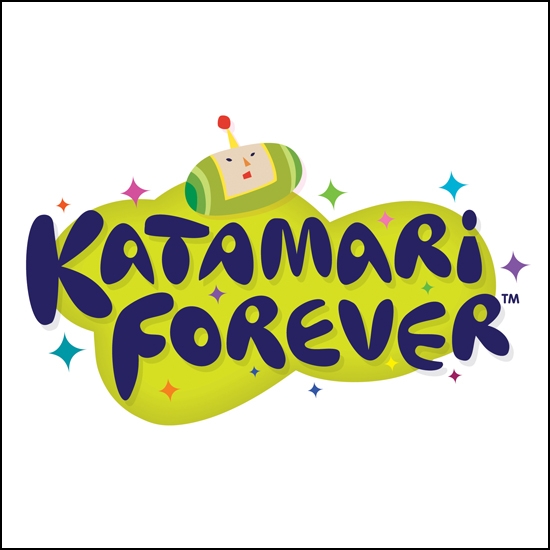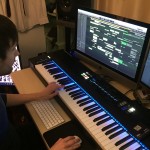Whether or not you like Katamari Damacy or not, you have to admire their creativity and sense of imagination. One of the highlights of each Katamari Damacy title has been an amazing soundtrack which usually feature quirky yet extremely high quality performances in both English in Japanese, many of which have become so popular that they’ve received their own chiptune arrangements.
We’ve been quite fortunate to get some time with the man behind the audio of Katamari Damacy, Yu Miyake, who has been working on the series since its inception. The main focus of this interview is the recently-released Katamari Forever and the high quality remixes of previous Katamari Damacy material that it features along with how he came to work at Namco and some other artists he admires. I also want to be sure to note that Tommy Ciulla and I collaborated on these questions, as he’s an even bigger fan than I am!
It’s a fun time, so join us in our interview after the jump.
OSV: Miyake-san, it’s a huge pleasure to get to speak with you about Katamari Damacy and your work at Namco Bandai. Let’s start from the top with a question about Katamari Forever. What went into the decision to feature mainly remixes this time around? Is the team finding it difficult to create even more catchy tunes than those featured in previous titles?
Miyake: Thank you so much. I truly feel honored to be respected by you.
I originally had plans for up to two Katamari sequels. The first game would feature all Japanese artists, the second game would feature artists from around the world (unfortunately we didn’t have enough experience in English negotiations for this to happen), and the third game’s soundtrack would feature remixes from producers around the world. Since the Katamari series went to other platforms, I decided to keep the PlayStation games as one series and look at the other games in a different direction. That is why I asked someone else to direct the sound for the Xbox 360 version, and made the sound a bit different for the PSP game.
About the second question, what you described is almost right. It might get a little long but let me explain – The Katamari sound team doesn’t think of their projects as design work. An example of a situation we don’t want to find ourselves in is the following: a client coming in and feeding us information about what they want, in turn, sidelining whatever we feel is right for the project. The music of Katamari Damacy was created in an environment which fostered creativity and excitement for everyone involved. An interesting note is that Keita Takahashi, the director of the first two Katamari game, didn’t give us any detailed directions regarding sound design. We were able to create the music freely as we saw fit. In fact, we worked closely with the director, graphics team, and movie team to stimulate each other creatively during the production of the game. I feel that the sound team, along with an outstanding development team, was a vital component to the success of the first Katamari Damacy.
The first members of the Katamari sound team are doing their own work now. I will have to admit with regret that it was very difficult to find an environment which an individual can show their full creative ability while working on the previous titles. If we do make another Katamari game, I will totally change the concept of its sound direction.
OSV: There are some huge names behind some of these remixes, including YMCK and Leah Dizon. How did you get them on board for this project, and do you have any interesting stories about working with the various artists to put this soundtrack together?
Miyake: There surely were many interesting stories. You could actually read some of them in the
HMV link below. But it’s in Japanese. I wish someone could provide English translation:
http://www.hmv.co.jp/news/article/908180079/
OSV: There’s even a high school marching band track on this album. Nobody would have thought that you could perform music from Katamari Damacy with an orchestra, but based on these arrangements, it sounds entirely possible! What can you tell us about the work that went into this piece, and have you ever considered putting on a Katamari Damacy themed orchestral concert in Japan?
Miyake: I thought it would be a good idea to have a song that conveyed feelings of sweet and bitter memories of youth (“Seishun” in Japanese). High school students have so much going on in their lives. They have crushes, they are studying for exams, they’re practicing for band practice, and they are hanging out with friends drinking melon soda (melon is a common flavor of soda in Japan). So I think it is okay for them to make small mistakes in their performance. Actually, it’s better to make mistakes. They are young and have a lot to learn, but at the same time you can feel that spark of excitement inside of them. I thought this concept suits Katamari’s world very well, so I asked the Horikoshi High School band to play for Katamari Forever.
It was really difficult for me to get up at 5 o’clock in the morning to record the marching band. Also, their performance is much better than I expected. It is very hard to tell that these are teenagers performing without watching them play.
I have not thought about putting on a Katamari Damacy themed orchestral concert in Japan. We did have an idea when the first Katamari Damacy came out for a “Katamari Night.” The idea was to have all the vocalists together at a live venue, somewhere like the Ageha, the biggest night club in Japan. Unfortunately it couldn’t be coordinated at the time. However, this type of plan will have better results if it is thrown by an unofficial third party like yourself. Please call me when you make this a reality. I am very interested how I will feel watching the performance.
OSV: What’s your favorite song from the first three Katamari Damacy titles? Is there a remix on the Katamari Forever soundtrack that turned you on to a track that you didn’t necessarily have any affinity for on the original soundtrack?
Miyake: My favorite is “Cherry Blossom Color Season.” This was kind of a presentation track for myself, showing that I could compose songs with point-blank chords and melody. I think it went pretty well, but I’m flattering myself.
With Katamari Forever, all the tunes were chosen based on who would be the best mixer for each song that both fans and the team loved. Therefore, it doesn’t have any music that we don’t care for. In fact, since I am a sound director who said okay to each song, I love them all.
OSV: One of my personal favorites has always been “LONELY ROLLING STAR.” In fact, I liked it so much, it was played during my wedding reception! Did you ever think the music you and the Namco Bandai created would be so loved by fans that it would find its way into these kinds of uses? How does that make you feel?
Miyake: Wow, at the wedding! Are you serious? I’d love to get married someday. Well, congratulations! Anyway, I wasn’t aware of any of this king of feedback in the past, though we can easily see people’s reaction on YouTube these days. So, I don’t know what to say… I’m touched. Honestly, Mr. Takahashi and I now understand why athletes cry after winning a big game. I’d love to continue to create music that resonates so deeply with people.
OSV: I have to ask for more information about Mr. Shigeru Matsuzaki. His track, “Shadow and Light” is absolutely amazing. What can you tell us about him, and about your experience working with him? There’s a point in this song where he holds a note for an entire 33 seconds. Was that done through technical magic, or did he seriously hold the note for that long?
Miyake: This song is surely a contender for the “How long you can hold a note” award. Because he is recognized as a very powerful singer in Japan, we wanted to reflect that characteristic in the song. It must be wonderful to move so many people by just saying “Ahhhh…” My aim for this track was for Mr. Matsuzaki to sing this primitive song like Tarzan, as he has a very attractive wildness about him.
OSV: I also have to ask about a track that was absent. “塊ホリディ” (Katamari Holiday) is pretty popular among fans, so how was it that it didn’t make the cut for Katamari Forever?
Miyake: So sorry. I wanted to include the song myself as well. To tell you the truth, this song was going to be arranged with a ukulele by Ms. Ayano Tsuji, but there was a conflict in the schedule. Hopefully we will have another chance to work on it.
OSV: What went into the decision to end the 2-disc soundtrack with the long electronic remixes and the ambient track rather than something big and grand and happy? I felt the long techno remixes didn’t really reference the Katamari universe outside of the occasional humming of the main theme.
Miyake: You are talking about “Hard Floor Remix?” I do agree that the humming and TB303 bass should have been more entwined. I do think that the “WANDA WANDA” proved that techno can fit Katamari’s style. The Katamari Forever soundtrack features two CDs worth of music. One is “Organic” and the other is “Electric.” When you want to feel relaxed, listen to the “Organic” songs. When you want to show the girls how sharp you are, go with “Electric.”
OSV: Talking about the Katamari Damacy franchise in general, tell us about your experience with the franchise over the years. How were you first approached to write music for the original Katamari Damacy, and was it particularly challenging?
Miyake: We all loved the concept behind Katamari Damacy. But because the idea was so eccentric, we felt that if we didn’t treat it properly the whole project could go horribly off track. The last thing we wanted was to have the game fall through the cracks and become a hidden gem.
Our objective for the game was to create a catchy pop soundtrack. In order to accomplish this goal we made sure to give the development team our full support. As a sound team we wanted to help establish the world of Katamari Damacy as much as we could through music.
My approach to developing music is that whenever I think of a song I grab the nearest recording device and hum its signature part. That is how Katamari Damacy’s main theme, “Nan-Nan Damacy” was created. Curiously enough, not trying too many things makes for quite a song. This can be heard with the simple humming in the main theme. It may be cliché, but music is raw and alive. I guess you could say it’s sort of similar to seducing the opposite sex.
OSV: You’ve been at Namco Bandai for a long. How did you come to work at the company? It seems you used to do a lot more composing, but have been more of a contributor lately than a lead composer. How has your role changed over the past several years, and where do you see yourself going from where you are now?
Miyake: Looking at myself as just a contributor makes my skin crawl. I still want to be an active composer and would love to work on energetic projects. I would love to work on something that has the power to make people happy, no matter how they are feeling. As for the future, I’m currently hard at work on an album as Eutron. Please stay tuned.
OSV: Your work on the now hard-to-find Nanosounds albums (Swinging Circuit, Steal the Scene, Delight in Daylight) is some of your most creative and unique. Do you have any plans to compile these songs along with other non-game works of yours and release them on a seperate CD, similar to what Noboyoshi Sano did with his “sanodg works” album?
Miyake: Mr. Sano is someone whom I have absolute respect for, and is also considered a rival of mine. I never intend to imitate his approach, but I do have plans for some non-game related projects. Please stay tuned for those as well!
OSV: To ask about a few select tracks, one of our writers is obsessed with “Orange” and “Pulse Phaze,” so we were curious if you could tell us what inspired these tracks. Also, we noticed that your unused BGM from Ride Racer V, “Quadra,” made its way into Tekken 4 as a character select theme. Are there any other interesting instances of this happening during your time at Namco Bandai?
Miyake: Really?! Thank you so much. We should have a drink together sometime. Back then I was addicted to a piece of software called Reactor. With it, I was designing at least one new instrument with the creation of each new track. If I remember correctly, I made “Orange” thinking only about making it sound how I would like it, in this case, I tried to make it sound three dimensional in form from the beginning to the end of the track. It is like making an abstract sculpture type of feeling. I think the interesting thing about music is that the “form” changes as time goes by. I was probably also trying to create the common sounds of kick drums and hi-hats from something totally different.
“PulsePhaze” was originally a disco track with a main guitar. I remember making a sampler with a sequencer in Reactor and adding more than 40 chopped tracks from Ridge Racer. I believe we also put in sounds from Pole Position. I wanted to secretly pay homage to old Namco racing games. There were other incidents where songs that were declined once were used for different games.
OSV: Do you listen to any video game music outside of the works you have composed for? If so, do you have a favorite album or series? Does any other game music inspire your compositions?
Miyake: Years ago I would get my hands on masters of game soundtracks from arcades and record them. I would listen to those quite frequently. I also frequently listened to “Computer Game” from YMO’s first album a lot. There are also plenty of arcade music from Namco, Taito, Konami, Nihon Bussan, Tecmo and Sega that inspired me. As for console games, I think Balloon Fight by Mr. Hirokazu Tanaka is fantastic, and I also listened to Mr. Uematsu’s Final Fantasy music up until the fifth game. There are a multitude of recent composers that have influenced me. A few of them are Mr. Sugiyama who worked on Rez, Mr. Suzuki from Square Enix is a buddy of mine, the sound creators on LocoRoco must be really good. I think Mr. Kosaki from MONACA is quite awesome as well. I also like the work of Media Moleule. I am also very fond of Mr. Horigome (Kirinji) who used to be my mentor. I also can’t forget all my co-workers Mr. Yano, Mr. Tohyama, Mr. Tobeta, Ms. Misumi, and Asuka Sakai.
OSV: Thank you for your time. Please keep up the great work, and we look forward to hearing what’s next!
Miyake: All righty! I am making the iPhone version of Noby Noby Boy right now, so check that out as well!
Tags: Interviews, Katamari Damacy, Katamari Forever, Leah Dizon, Namco Bandai, Remixes, YMCK, Yu Miyake









































Yayy!
great interview!
FINALLY got back to read this! Great stuff, thank you!